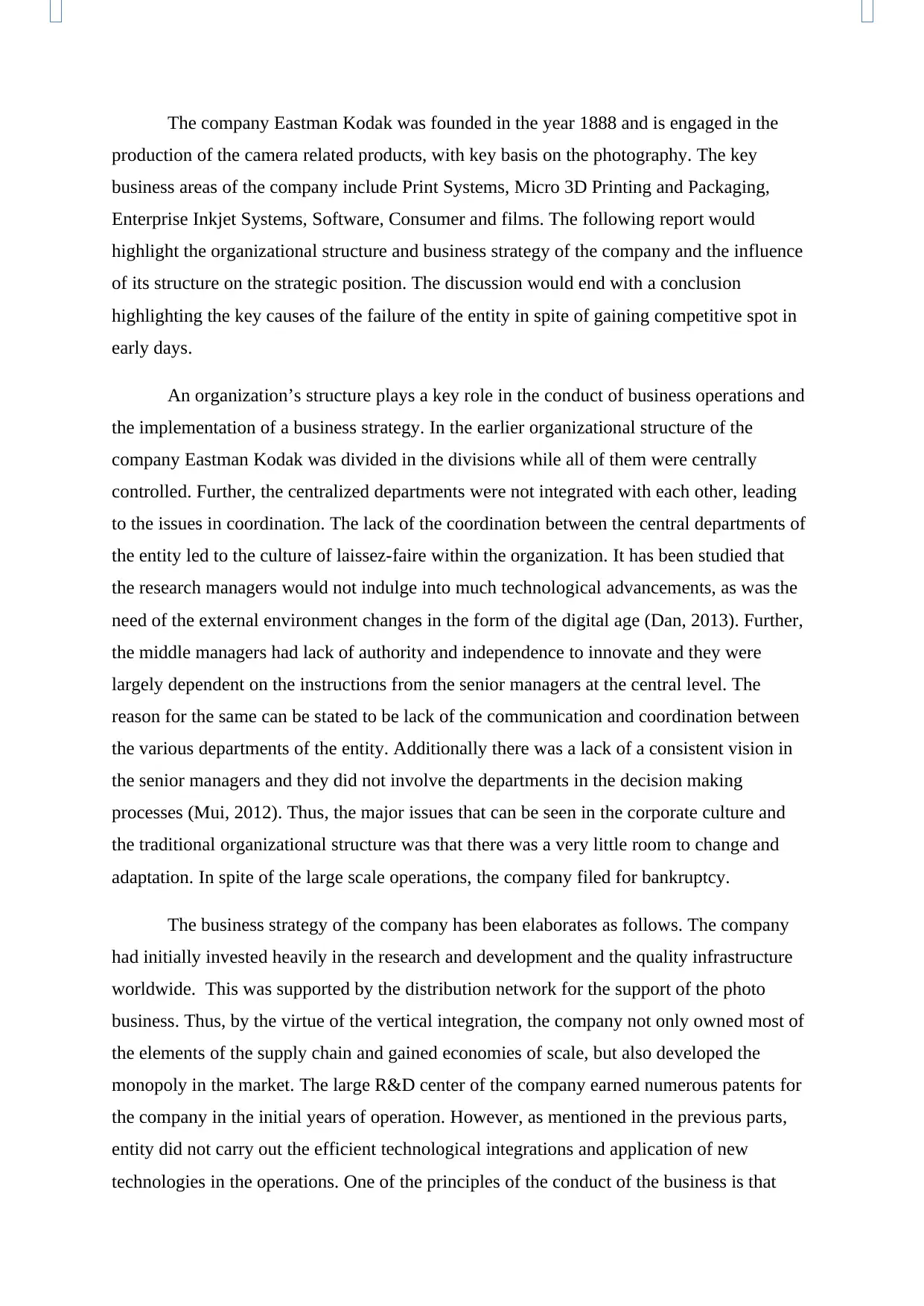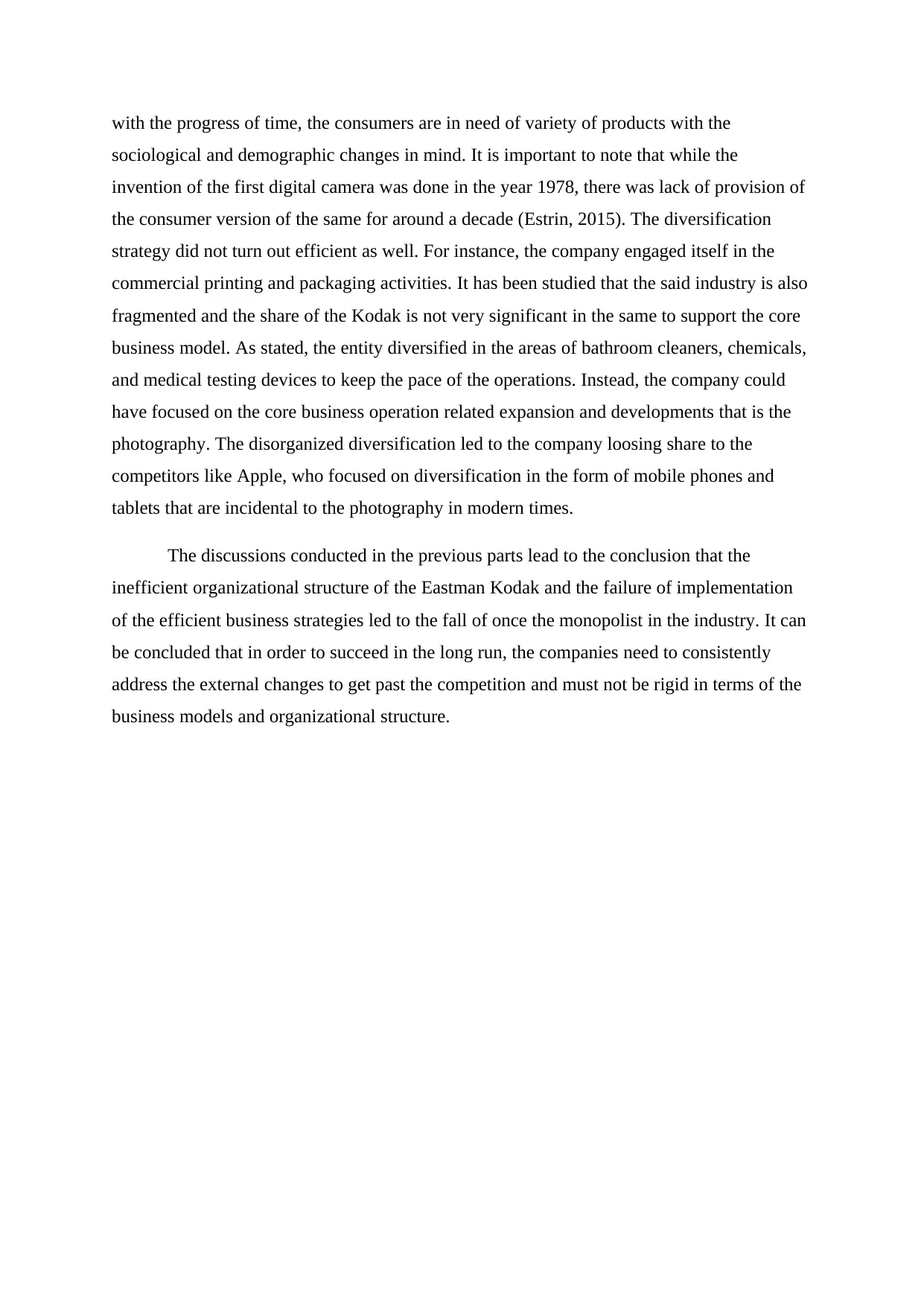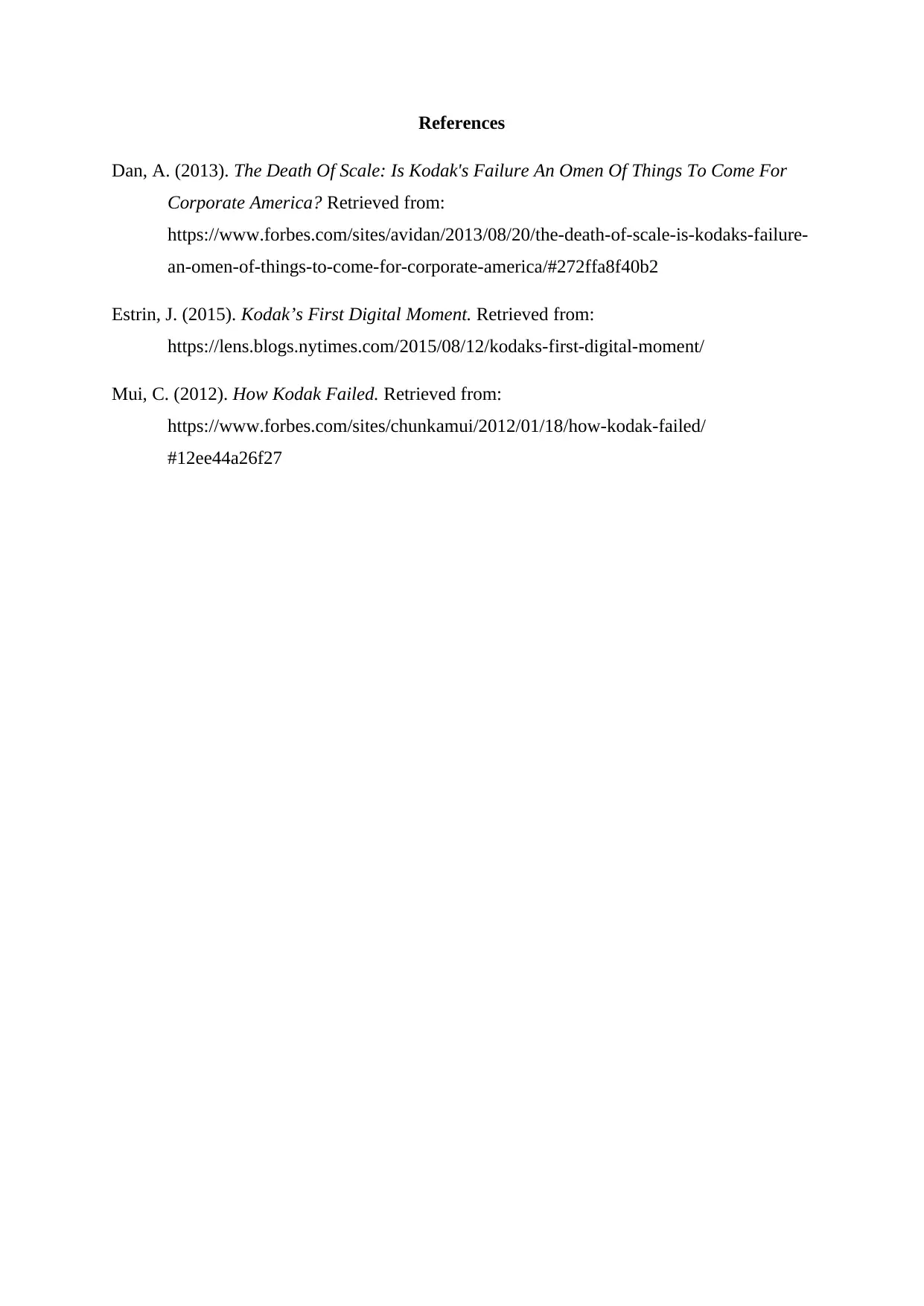Economics for Managers: Kodak Case Study Analysis Report
VerifiedAdded on 2022/08/29
|4
|882
|26
Case Study
AI Summary
This case study analyzes the Eastman Kodak company, exploring its organizational structure and business strategy in the context of economic principles. It examines how Kodak's initial success, built on vertical integration and a strong research and development focus, was undermined by an inefficient organizational structure and a failure to adapt to the changing market, particularly the digital revolution. The analysis highlights the impact of centralized control, lack of coordination between departments, and a lack of innovation, which ultimately led to the company's decline despite early market dominance. The study also discusses the failure of diversification strategies and the rise of competitors like Apple, emphasizing the importance of adapting to external changes and maintaining a flexible business model to ensure long-term success in the industry.

ECONOMICS FOR MANAGERS
CASE STUDY ANALYSIS
CASE STUDY ANALYSIS
Paraphrase This Document
Need a fresh take? Get an instant paraphrase of this document with our AI Paraphraser

The company Eastman Kodak was founded in the year 1888 and is engaged in the
production of the camera related products, with key basis on the photography. The key
business areas of the company include Print Systems, Micro 3D Printing and Packaging,
Enterprise Inkjet Systems, Software, Consumer and films. The following report would
highlight the organizational structure and business strategy of the company and the influence
of its structure on the strategic position. The discussion would end with a conclusion
highlighting the key causes of the failure of the entity in spite of gaining competitive spot in
early days.
An organization’s structure plays a key role in the conduct of business operations and
the implementation of a business strategy. In the earlier organizational structure of the
company Eastman Kodak was divided in the divisions while all of them were centrally
controlled. Further, the centralized departments were not integrated with each other, leading
to the issues in coordination. The lack of the coordination between the central departments of
the entity led to the culture of laissez-faire within the organization. It has been studied that
the research managers would not indulge into much technological advancements, as was the
need of the external environment changes in the form of the digital age (Dan, 2013). Further,
the middle managers had lack of authority and independence to innovate and they were
largely dependent on the instructions from the senior managers at the central level. The
reason for the same can be stated to be lack of the communication and coordination between
the various departments of the entity. Additionally there was a lack of a consistent vision in
the senior managers and they did not involve the departments in the decision making
processes (Mui, 2012). Thus, the major issues that can be seen in the corporate culture and
the traditional organizational structure was that there was a very little room to change and
adaptation. In spite of the large scale operations, the company filed for bankruptcy.
The business strategy of the company has been elaborates as follows. The company
had initially invested heavily in the research and development and the quality infrastructure
worldwide. This was supported by the distribution network for the support of the photo
business. Thus, by the virtue of the vertical integration, the company not only owned most of
the elements of the supply chain and gained economies of scale, but also developed the
monopoly in the market. The large R&D center of the company earned numerous patents for
the company in the initial years of operation. However, as mentioned in the previous parts,
entity did not carry out the efficient technological integrations and application of new
technologies in the operations. One of the principles of the conduct of the business is that
production of the camera related products, with key basis on the photography. The key
business areas of the company include Print Systems, Micro 3D Printing and Packaging,
Enterprise Inkjet Systems, Software, Consumer and films. The following report would
highlight the organizational structure and business strategy of the company and the influence
of its structure on the strategic position. The discussion would end with a conclusion
highlighting the key causes of the failure of the entity in spite of gaining competitive spot in
early days.
An organization’s structure plays a key role in the conduct of business operations and
the implementation of a business strategy. In the earlier organizational structure of the
company Eastman Kodak was divided in the divisions while all of them were centrally
controlled. Further, the centralized departments were not integrated with each other, leading
to the issues in coordination. The lack of the coordination between the central departments of
the entity led to the culture of laissez-faire within the organization. It has been studied that
the research managers would not indulge into much technological advancements, as was the
need of the external environment changes in the form of the digital age (Dan, 2013). Further,
the middle managers had lack of authority and independence to innovate and they were
largely dependent on the instructions from the senior managers at the central level. The
reason for the same can be stated to be lack of the communication and coordination between
the various departments of the entity. Additionally there was a lack of a consistent vision in
the senior managers and they did not involve the departments in the decision making
processes (Mui, 2012). Thus, the major issues that can be seen in the corporate culture and
the traditional organizational structure was that there was a very little room to change and
adaptation. In spite of the large scale operations, the company filed for bankruptcy.
The business strategy of the company has been elaborates as follows. The company
had initially invested heavily in the research and development and the quality infrastructure
worldwide. This was supported by the distribution network for the support of the photo
business. Thus, by the virtue of the vertical integration, the company not only owned most of
the elements of the supply chain and gained economies of scale, but also developed the
monopoly in the market. The large R&D center of the company earned numerous patents for
the company in the initial years of operation. However, as mentioned in the previous parts,
entity did not carry out the efficient technological integrations and application of new
technologies in the operations. One of the principles of the conduct of the business is that

with the progress of time, the consumers are in need of variety of products with the
sociological and demographic changes in mind. It is important to note that while the
invention of the first digital camera was done in the year 1978, there was lack of provision of
the consumer version of the same for around a decade (Estrin, 2015). The diversification
strategy did not turn out efficient as well. For instance, the company engaged itself in the
commercial printing and packaging activities. It has been studied that the said industry is also
fragmented and the share of the Kodak is not very significant in the same to support the core
business model. As stated, the entity diversified in the areas of bathroom cleaners, chemicals,
and medical testing devices to keep the pace of the operations. Instead, the company could
have focused on the core business operation related expansion and developments that is the
photography. The disorganized diversification led to the company loosing share to the
competitors like Apple, who focused on diversification in the form of mobile phones and
tablets that are incidental to the photography in modern times.
The discussions conducted in the previous parts lead to the conclusion that the
inefficient organizational structure of the Eastman Kodak and the failure of implementation
of the efficient business strategies led to the fall of once the monopolist in the industry. It can
be concluded that in order to succeed in the long run, the companies need to consistently
address the external changes to get past the competition and must not be rigid in terms of the
business models and organizational structure.
sociological and demographic changes in mind. It is important to note that while the
invention of the first digital camera was done in the year 1978, there was lack of provision of
the consumer version of the same for around a decade (Estrin, 2015). The diversification
strategy did not turn out efficient as well. For instance, the company engaged itself in the
commercial printing and packaging activities. It has been studied that the said industry is also
fragmented and the share of the Kodak is not very significant in the same to support the core
business model. As stated, the entity diversified in the areas of bathroom cleaners, chemicals,
and medical testing devices to keep the pace of the operations. Instead, the company could
have focused on the core business operation related expansion and developments that is the
photography. The disorganized diversification led to the company loosing share to the
competitors like Apple, who focused on diversification in the form of mobile phones and
tablets that are incidental to the photography in modern times.
The discussions conducted in the previous parts lead to the conclusion that the
inefficient organizational structure of the Eastman Kodak and the failure of implementation
of the efficient business strategies led to the fall of once the monopolist in the industry. It can
be concluded that in order to succeed in the long run, the companies need to consistently
address the external changes to get past the competition and must not be rigid in terms of the
business models and organizational structure.
⊘ This is a preview!⊘
Do you want full access?
Subscribe today to unlock all pages.

Trusted by 1+ million students worldwide

References
Dan, A. (2013). The Death Of Scale: Is Kodak's Failure An Omen Of Things To Come For
Corporate America? Retrieved from:
https://www.forbes.com/sites/avidan/2013/08/20/the-death-of-scale-is-kodaks-failure-
an-omen-of-things-to-come-for-corporate-america/#272ffa8f40b2
Estrin, J. (2015). Kodak’s First Digital Moment. Retrieved from:
https://lens.blogs.nytimes.com/2015/08/12/kodaks-first-digital-moment/
Mui, C. (2012). How Kodak Failed. Retrieved from:
https://www.forbes.com/sites/chunkamui/2012/01/18/how-kodak-failed/
#12ee44a26f27
Dan, A. (2013). The Death Of Scale: Is Kodak's Failure An Omen Of Things To Come For
Corporate America? Retrieved from:
https://www.forbes.com/sites/avidan/2013/08/20/the-death-of-scale-is-kodaks-failure-
an-omen-of-things-to-come-for-corporate-america/#272ffa8f40b2
Estrin, J. (2015). Kodak’s First Digital Moment. Retrieved from:
https://lens.blogs.nytimes.com/2015/08/12/kodaks-first-digital-moment/
Mui, C. (2012). How Kodak Failed. Retrieved from:
https://www.forbes.com/sites/chunkamui/2012/01/18/how-kodak-failed/
#12ee44a26f27
1 out of 4
Related Documents
Your All-in-One AI-Powered Toolkit for Academic Success.
+13062052269
info@desklib.com
Available 24*7 on WhatsApp / Email
![[object Object]](/_next/static/media/star-bottom.7253800d.svg)
Unlock your academic potential
Copyright © 2020–2025 A2Z Services. All Rights Reserved. Developed and managed by ZUCOL.





